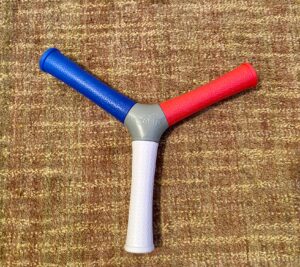Over the years, I have tested many different fitness products through my work with Personal Fitness Professional Magazine. I am not paid to promote any products on my site, and this latest review comes after spending the past few weeks using this particular product in the clinic with my patients. I am pleased to bring attention to it because I think it can help with recovery and training.
Recently, the inventor of the HECOstix, Josh Broeker, reached out to me to see if I have had a chance to use his product. Much to my surprise, I was not familiar with it. As a performance physical therapist working with many athletes from various sports and ranging from youth to professionals, I was naturally excited to see the product in action. I am always looking for ways to enhance neurocognitive training and my rehab. Josh was gracious enough to send me a few HECOstix to try out.
For those unfamiliar with the product, see the image of the Red, White and Blue version below:

As I rehab and progress athletes back to sport after injury, implementing tools to improve hand eye coordination, reaction time, cognitive skills and decision making is important prior to sending them back to practice and sport. A few of the really cool features I like about this product include:
- Lightweight and durable EVA make-up
- Different versions and multiple colors allow for auditory cues and quick reaction
- It can be used safely by all ages and abilities
- Travels easily with you anywhere
The HECOstix can be used for virtually any sport and done indoors or outdoors. Perhaps the greatest thing about the product is that it injects FUN into training while allowing users to compete against others or their own results in an effort to improve performance. This tool also allows for progressive challenges moving from underhand to sideways to overhead throws depending on the functional demands and skill level of the participants.
In the clinic, I have been using it with some of my patients rehabbing after ACL reconstruction. Adding neurocognitive training is essential for full recovery and secondary prevention. below is an article from Sports health discussing neurocognitive and neurophysiological functions related to ACL injury:
https://pubmed.ncbi.nlm.nih.gov/34236003/
Specifically, I have integrated it with dynamic balance and movement drills calling out a color while throwing the HECOstix toward the client. I have also had a pair of patients throwing and calling out the color as part of a rehab game. I will be continuing to use it with this population and other athletes working on hand eye coordination and cognitive training for their sport.
If you are looking to add a new wrinkle to your training or rehab, I highly recommend giving this product a try. For more information on the product, be sure to visit www.hecostix.com.



